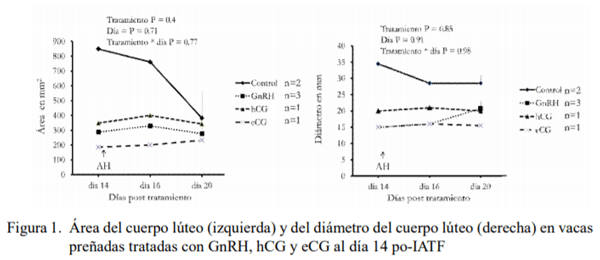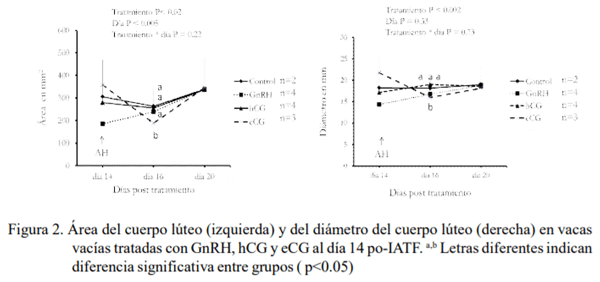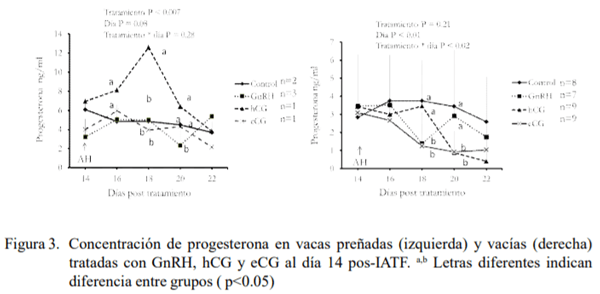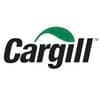Tratamientos hormonales aplicados posterior a la IATF sobre la tasa de preñez y la viabilidad embrionaria en vacas de alta producción en estrés térmico
El objetivo del estudio fue evaluar el efecto de GnRH, hCG y eCG aplicados 14 días después de la inseminación artificial a tiempo (IATF) fijo sobre la tasa de preñez y sobrevivencia embrionaria y fetal en vacas sometidas a estrés calórico. Las vacas (n=234) fueron sincronizadas e inseminadas y recibieron diferentes dosis hormonales vía i.m. 14 días después: a) Grupo control: 2 ml de suero fisiológico (n=56), b) Grupo GnRH: 100 µg de GnRH (n=58), Grupo c) hCG: 1500 UI de hCG (n=60), y d) Grupo eCG: 400 UI de eCG (n=60). El diagnóstico de gestación y la evaluación del número de cuerpos lúteos (CL) se determinó mediante ultrasonografía a los días 34, 45 y 60 de la IA. Las vacas tratadas con GnRH presentaron una mayor tasa de preñez (p<0.05) y sin diferencias significativas entre los demás grupos. La sobrevivencia embrionaria y fetal entre los días 45 y 60 fue constante en todos los grupos, pero ocurrió una muerte fetal en el grupo eCG. No hubo diferencia significativa en la proporción de cuerpos lúteos accesorios entre los grupos tratados y el grupo control a los 60 días de gestación. Se concluye que la administración de GnRH 14 días pos-IATF mejora la tasa de preñez en vacas lecheras sometidas a estrés calórico.
Palabras clave: vacas de alta producción; GnRH; tasa de preñez; progesterona; cuerpo lúteo




1. Bartolome JA, Kamimura S, Silvestre F, Arteche AC, Trigg T, Thatcher WW. 2006. The use of a deslorelin implant (GnRH agonist) during the late embryonic period to reduce pregnancy loss. Theriogenology 65: 1443-1453. doi: 10.1016/j.theriogenology.2005.08.017
2. Bartolome JA, Perez S, de la Sota RL, Thacher WW. 2012. The effect of administering equine chorionic gonadotropin (eCG) and human chorionic gonadotropin (hCG) post artificial insemination on fertility of lactating dairy cows. Theriogenology 78: 1110-1116. doi: 10.1016/j.theriogenology.2012.05.006
3. BonDurant RH. 2007. Selected diseases and conditions associated with bovine conceptus loss in the first trimester. Theriogenology 68: 461-473. doi: 10.1016/j.theriogenology.2007.- 04.022
4. Cruz JE, Elizondo CA, Ulloa AR. 2009. Efecto de la GnRH post inseminación sobre la concentración de progesterona y las tasas de concepción en vacas repetidoras Holstein en condiciones de estrés calórico. Tec Pecu Mex 47: 107-115
5. De Rensis F, Scaramuzzi RJ. 2003. Heat stress and seasonal effects on reproduction in the dairy cow - a review. Theriogenology 60: 1139-1151. doi: 10.1016/S0093-691X(03)00126-2
6. Diskin MG, Morris DG. 2008. Embryonic and early foetal losses in cattle and other ruminants. Reprod Domest Anim 43: 260-267. doi: 10.1111/j.1439- 0531.2008.01171.x.
7. Ealy AD, Drost M, Hansen PJ. 1993. Developmental changes in embryonic resistance to adverse effects of maternal heat stress in cow. J Dairy Sci76: 2899-2905. doi: 10.3168/jds.S0022- 0302(93)77629-8
8. García-Inspierto I, López-Gatius F. 2012. Effects of GnRH or progesterone treatment on day 5 post -AI on plasma progesterone, luteal blood flow and leucocyte counts during the luteal phase in dairy cows. Reprod Domest Anim 47: 224-229. doi: 10.1111/j.1439-0531.2011.- 01832.x
9. Jordan ER. 2003. Effects of heat stress on reproduction. J Dairy Sci 86: 104-114. doi: 10.3168/jds.S0022-0302(03)74043-0
10. López-Gatius FP, Santolaria JL, Yaniz J, Rutllant M, López-Bejar. 2002. Factors affecting pregnancy loss from gestation Day 38 to 90 in lactating dairy cows from a single herd. Theriogenology 57: 1251-1261. doi: 10.1016/S0093-691X(01)00715-4
11. López-Gatius, F. 2003. Is fertility declining in dairy cattle? a retrospective study in northeastern Spain. Theriogenology 60: 89-99. doi: 10.1016/S0093- 691X(02)01359-6
12. López-Gatius F, Santolaria P, Martino A, Delétang F, De Rensis F, 2006. The effects of GnRH treatment at the time of AI and 12 days later on reproductive performance of high producing dairy cows during the warm season in northeastern Spain. Theriogenology 65: 820-830. doi: 10.1016/j.theriogenology.- 2005.07.002
13. Narvaez J. 2010. Efecto de la administración de eCG entre los días 16 y 22 post inseminación artificial sobre la concepción y el retorno al celo en vacas lecheras. Tesis de Magíster. Córdoba, Argentina: Univ. Nacional de Córdoba. 18 p.
14. Núñez R. 2011. Utilización de gonadotrofina coriónica equina (eCG) en vacas de carne, sobre la tasa de preñez y pérdidas embrionarias en un programa de inseminación artificial a tiempo fijo. Tesis de Magíster. Córdoba, Argentina: Univ. Nacional de Córdoba. 56 p.
15. Rajamahendran R, Ambrose JD, Schmitt EJ, Thatcher MJ, Thatcher WW. 1998. Effect of buserelin injection and deslorelin (GnRH-agonist) implants on plasma progesterone, LH, accessory CL formation, follicle and corpus luteum dynamics in holstein cows. Theriogenology 50: 1141-1155. doi: 10.1016/s0093-691x(98)00215-5
16. Rajamahendran R, Sianangama PC. 1992. Effect of human chorionic gonadotrophin on dominant follicles in cows: formation of accessory corpora lutea, progesterone production and pregnancy rates. J Reprod Fertil 95: 577- 584. doi: 10.1530/jrf.0.0950577
17. Rendel A. 1997. Efecto de GnRH (Buseralina) en vacas de lechería, inyectadas al día 0 o 7 post inseminacion artificial. Tesis de Médico Veterinario. Valdivia, Chile: Univ. Austral de Chile. 54 p.
18. Santos J, Thatcher WW, Pool L, Overton MW. 2001. Effect of human chorionic gonadotropin on luteal function and reproductive performance of highproducing lactating Holstein dairy cows. J Anim Sci 79: 2881-2894. doi: 10.2527/ 2001.79112881x
19. Santos JE, Thatcher WW, Chebel RC, Cerri RL, Galvão KN. 2004. The effect of embryonic death rates in cattle in the efficacy of estrus synchronization programs. Anim Reprod Sci 82: 513-535. doi: 10.1016/j.anireprosci.2004.04.015
20. Schmitt EJ, Diaz T, Barros CM, de la Sota RL, Drost M, Fredriksson EW, Staples CR, et al. 1996. Differential response of the luteal phase and fertility in cattle following ovulation of the firstwade follicle with human chorionic gonadotropin or an agonist of gonadotropin-releasing hormone. J Anim Sci 74: 1074-1083. doi: 10.2527/1996.7451074x
21. Sreenan JM, Diskin MG, Morris DG. 2001. Embryo survival rate in cattle: a major limitation to the achievement of high fertility. In: Fertility in the high producing dairy cow. 26 Occ Publ Br Soc Anim Sci 26: 93-104. doi: 10.1017/ S0263967X00033619
22. Thatcher WW, Staples CR, DanetDesnoyers G, Oldick B, Schmitt EP. 1994. Embryo health and mortality in sheep and cattle. J Anim Sci 72(Suppl 3): 16-30. doi: 10.2527/1994.72- suppl_316x
23. Ullah G, Fuquay JW, Keawkhong T, Clark BL, Pogue DE, Murphey EJ. 1996. Effect of gonadotropin-releasing hormone at estrus on subsequent luteal function and fertility in lactating Holsteins during heat stress. J Dairy Sci 79: 1950- 1953. doi: 10.3168/jds.S0022-0302(96)- 76565-7
24. Vanroose G, de Kruif A, Van Soom A. 2000. Embryonic mortality and embryopathogen interactions. Anim Reprod Sci 60: 131-143. doi: 10.1016/S0378- 4320(00)00098-1
25. Wathes DC. 1992. Embryonic mortality and the uterine environment. J Endocrinol 134: 321-325. doi: 10.1530/jrf.0.0840393
26. Willard S, Gandy S, Bowers S, Graves K, Elias A, Whisnant C. 2003. The effects of GnRH administration post insemination on serum concentrations of progesterone and pregnancy rates in dairy cattle exposed to mild summer heat stress. Theriogenology 59: 1799-1810. doi: 10.1016/s0093-691x(02)- 01232-3
27. Zahid P, Cahit K. 2010. The effects of GnRH and hCG used during and after artificial insemination on blood serum progesterone levels and pregnancy rate in cows. Kafkas Univ Vet Fak 16: 371-375.













